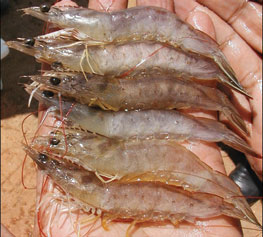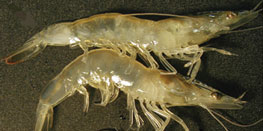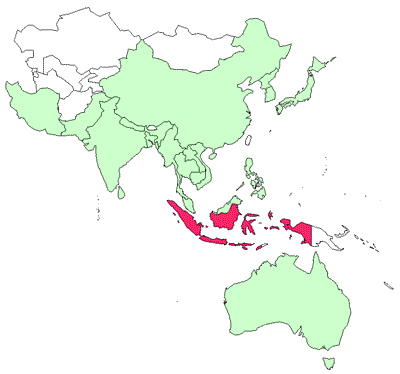Diseases of crustaceans
Viral diseases—Infectious myonecrosis
CLICK ON IMAGE TO ENLARGE


Source: DV Lightner
Signs of disease
Important: animals with disease may show one or more of the signs below, but disease may still be present in the absence of any signs.
Disease signs at the farm level
- large numbers of sick animals and significant mortalities in juvenile and subadult pond-reared stocks of Penaeus vannamei
Clinical signs of disease in an infected animal
- acute form of disease produces gross signs and elevated mortalities, but disease progresses to a chronic phase with persistent low-level mortalities
- focal to extensive white necrotic areas in the striated muscle, especially of the distal abdominal segments and tail fan (which might become necrotic and reddened in some individuals)
Disease agent
The causative agent is infectious myonecrosis virus, an RNA virus.
Host range
Crustaceans known to be susceptible to infectious myonecrosis:
white shrimp* (Penaeus vannamei)
tiger prawn (Penaeus monodon)
blue shrimp (Penaeus stylirostris)
* naturally susceptible (other species have been shown to be experimentally susceptible)
Presence in Asia–Pacific

Infectious myonecrosis has been officially reported from Indonesia.
Epidemiology
- Infectious myonecrosis is a new viral disease identified recently in northeast Brazil in cultured P. vannamei. However, shrimps with similar gross signs have been also reported from other countries where P. vannamei are cultured.
- Affected life stages include juveniles and subadults. Significant mortalities occur in juvenile and subadult pond-reared populations.
- Extremes in salinity and temperature seem to be associated with disease outbreaks.
- Horizontal transmission has been demonstrated, but there is no information on vertical transmission.
Differential diagnosis
The differential diagnostic table and the list of similar diseases appearing at the bottom of each disease page refer only to the diseases covered by this field guide. Gross signs observed might well be representative of a wider range of diseases not included here. Therefore, these diagnostic aids should not be read as a guide to a definitive diagnosis, but rather as a tool to help identify the listed diseases that most closely account for the gross signs.
Similar diseases
Sample collection
Because of uncertainty in differentiating diseases using only gross signs, and because some aquatic animal disease agents might pose a risk to humans, you should not try to collect samples unless you have been trained. Instead, you should phone your national hotline number and report your observations. If samples have to be collected, the agency taking the call will advise you on what you need to do. Local or district fisheries/veterinary authorities could advise you on sampling.
Emergency disease hotline
For your national emergency disease hotline number, see Whom to contact if you suspect a disease.

